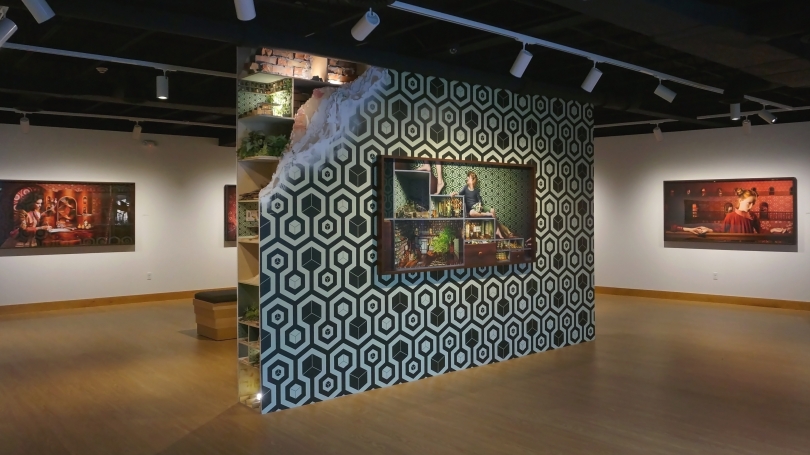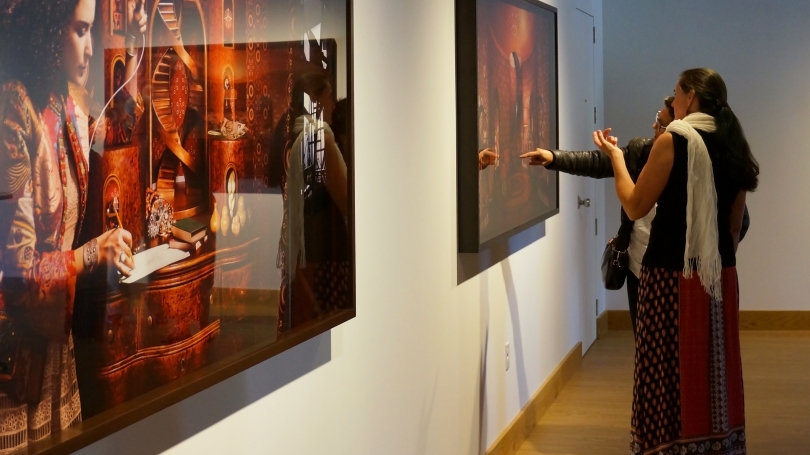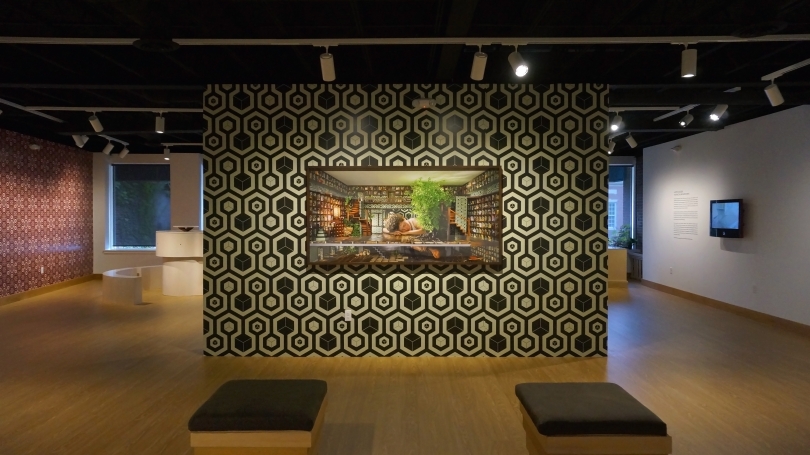Hood Quarterly, autumn 2016
John Stomberg, Virginia Rice Kelsey 1961s Director
Fractals abound in nature, unfold mathematically, and have inspired a new generation of computer-based image-makers who bridge science and art to create abstract patterns. Laetitia Soulier is not one of them. Though she is deeply engaged in the visual possibilities that fractals offer, her artistic practice asserts human creativity and handcraft in a universe most often understood digitally, and does so with naturalistic, if manufactured, environments. Her work embraces contradiction, complexity, and ambiguity in a manner both marvelous and mysterious, all of which makes her photographs the perfect focus for the inaugural exhibition at the Hood Downtown exhibition space.
The Fractal Architectures, the exhibition’s title, refers to a series of images the artist has created over the last few years; the principal that determines the scale of the architecture on display is based on fractal patterning. Essentially, this means a pattern that can be repeated infinitely while always remaining fundamentally the same in all but size. The classic example of this is a triangle to which is added three smaller triangles that leave one equivalent vacant triangle (see diagram). This same process can be repeated for each of the smaller, empty triangles, recreating the larger pattern at a diminished scale. Theoretically, this process can go on infinitely. It is the design principal found in the spirals of a seashell, in the branching of a tree, and in the cosmos. Soulier uses fractals to define her carefully built environments occupied by humans: Lilliputian universes constructed of logic and imagination in equal parts.
She names each sub-series (The Matryoshka Dolls and The Square Roots) after the formula for the fractal logic involved with that set of interiors. The “tell” is the wallpaper—each series has a pattern that visually represents the organizing principal involved. Matryoshka dolls are Russian folk art toys where multiple figures of similar form nest inside one another. The same idea can be found in toys from other areas of the world as well. These are usually limited to five, six, or seven pieces that fit snugly inside the largest figure. Conceptually, they could keep growing and shrinking at the same ratio (in this case, 1:2). This relationship is expressed in the red wallpaper that denotes the series. Similarly, the principal of a square root (1:16, 1:4, 1:2) defines the second group of images, and we can find that represented in the green pattern she uses.
Soulier starts her work by laboriously creating scale models of the scenes she imagines. Each piece of furniture, window, door, and small object that occupies her interiors is handmade. To create a series of photographs, she makes a separate model of a given space for each completed image, since each model accommodates only a single vantage point. She reuses individual components within the interior, but the walls and floors have to be rebuilt for each image. Every unique stage set can be carefully lit from multiple directions. Soulier then creates multiple exposures of each tableau to allow for changes in how each section is viewed. These she unites in post-production using her computer. The seamless reality of the finished image is a testimony to her skills with both hand and computer tools.
The models in the Hood Downtown exhibition are assembled after the fact. They capture the feel of the world Soulier creates photographically, and they reuse many of the objects she makes for her original photographic sets, but they offer an alternative experience by extending the role of the imagination. With them we are able to project ourselves into the scenes and relish the wonder of the world she has created. As open-ended as the photographs are, allowing for seemingly unending interpretive possibilities, they nevertheless freeze time. The models, on the other hand, encourage a participatory engagement that unfolds across time and space differently from their two-dimensional cousins. We move around them as objects and examine them from multiple vantage points. Ultimately, the models invite us to enjoy a very serious form of play.
We’re all Alice here, to misquote Lewis Carroll. When we enter a gallery of Soulier’s work, the normal rules of reality are jettisoned, only to be replaced by a strict, if random, new logic of time and space. As she will tell you herself, it is no mistake that the children in her work appear to be about eight years old. That is the time in children’s development when they begin to learn science and start appreciating life as a complicated natural system, but they still retain enough of their youthful imagination to relish a more magical understanding of the world. This exhibition brings that precarious moment to life, creating scenes forged from a combination of poetry and mathematics that teeter between fantasy and logic.
Soulier’s work extends and adds significantly to the history of creating tableaux in photography. This is a story that most likely began in the 1850s, when the Swedish photographer Oscar Rejlander (who, not surprisingly, befriended Lewis Carroll after moving to England) used multiple negatives to sew together visual allegories with complex narratives. Rejlander, like Soulier, used a combination of stagecraft and darkroom techniques to achieve an opulent visual repertory that pre-existed only in his imagination. While the specific tools have changed, this creative impulse remains. In many ways, Rejlander’s work more closely relates to Soulier’s than does the work of other contemporary artists photographing architectural models. Oliver Boberg, Thomas Demand, and James Casebere, for example, construct moody, ethereal, threatening, and banal scenes of uninhabited places that stand in marked contrast to the fantastical rooms Soulier creates.
Soulier’s photographs evoke a world rich in narrative possibility of the marvelous sort. Each work is an incomplete story—an open book with one page showing. Viewers are given the setting and a glimpse of the action, and the rest is up to the imagination. As we participate and engage, the works come to life and grow in unpredictable ways. This is the essential dichotomy Soulier evokes. Within the totally logical construct of a fractal-derived universe, where all scale can be determined in relation to what is visible, Soulier kindles tales whose beginnings and endings viewers can never know but can only imagine.
This article is adapted from an essay in the exhibition’s accompanying brochure.
Related Exhibitions
- Laetitia Soulier: The Fractal Architectures
- Bahar Behbahani: Let the Garden Eram Flourish
- Ingo Günther: World Processor
- Mining Big Data: Artists’ Global Concerns




